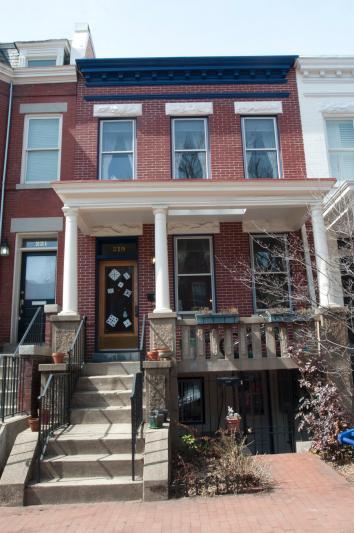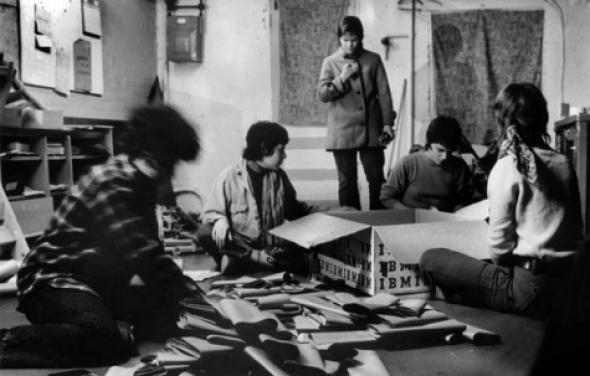The announcement earlier this week that the National Park Service had added the first explicitly lesbian site to the National Register of Historic Places should warm every American’s heart. The building in question is the row house on Washington, D.C.’s Capitol Hill where the lesbian separatist Furies Collective was based between the fall of 1971 and the summer of 1973.

Patsy Lynch
The 11th Street SE building was the operational center of the 12-woman collective of writers and artists and the birthplace of the early feminist publication The Furies. As Lillian Faderman explained in her 2015 book The Gay Revolution, the group’s name was a reference to “the three Greek goddesses with blood-red eyes and snakes for hair,” who took vengeance on mother-murdering Orestes by driving him crazy. In the first issue, Ginny Berson wrote: “We call our paper The FURIES because we are also angry. We are angry because we are oppressed by male supremacy. We have been fucked over all our lives by a system which is based on the domination of men over women. … We are working to change this system which has kept us separate and powerless for so long.”
The 12 women didn’t just work as a collective, they also cohabited, along with three children, in three separate spaces—one of which was the 11th Street row house. In her 1976 book Plain Brown Rapper, Rita Mae Brown—who was kicked out of the group in March 1972, apparently for “star-tripping”—explained: “We lived together, shared chores equally. All clothing rested in a common room. We slept together in mattresses on the floor in the same room.” Reached Thursday, Berson told me, “We were very deliberate about how we shared money. Women with more privilege, who could get better jobs, needed to put more in. Otherwise the women with least privilege and least education would be stuck working 40 hours a week at terrible jobs, and we wanted everyone to have time for political work.”
The collective’s publication, The Furies, “inspired thousands of lesbian feminists to form their own collectives in cities, farms, forests, and mountains all over America and in Europe, too,” according to Faderman. In the application for the building’s admission to the historic register, Mark Meinke of the LGBTQ history group Rainbow Heritage Network, notes that the first issue was a “mix of ideology, critiques of heterosexual feminism and polemic, biographical essays, poetry, personal essays, advice on self-reliance, and accounts of life in the collective.”* Brown—now known as a prolific author of cozy mysteries—”provided a political critique of Roxanne Dunbar’s The Movement and the Working Class and an essay on gossip.”
After the collective broke up and the magazine ceased publication, the women who made up the Furies continued to play key roles in lesbian, feminist, and lesbian feminist culture. As well as their individual contributions as photographers, writers, human rights workers, and academics, they went on to found important movement organizations such as Diana Press, Olivia Records, and Women in Distribution.
As the Washington Post noted, “the Obama administration is making a concerted effort to recognize the contribution of lesbian, gay, bisexual and transgender Americans to the nation’s past.” The Stonewall Inn is expected to be designated as the nation’s “first LGBTQ-themed national monument in American history,” perhaps as soon as next month, and the historic significance of places like Julius’ Bar and the Cherry Grove Community House and Theater have recently been recognized. There’s no doubt that important things happened in these places, but I feel conflicted about the way a location’s historic significance can lend commercial advantage to businesses that sometimes have little connection, other than a physical address, to those historic events. The home of the Furies Collective—like the residences of activists Bayard Rustin or Franklin E. Kameny and the Edificio Comunidad de Orgullo Gay de Puerto Rico, the San Juan building where the island’s first LGBTQ rights group held its meetings—has a more profound political resonance.

JEB (Joan E. Biren)
When I asked Berson what she saw as the Furies’ greatest achievements, she conceded that the group failed to accomplish its ultimate goal—“We didn’t succeed in smashing patriarchy or smashing capitalism.” Still, “although we weren’t the only ones who tried, we were the most successful at combining lesbianism and feminism and defining the politics of lesbian-feminism,” she told me. “We were pointing out the systemic nature of male supremacy—that it wasn’t just a bunch of men acting badly. These are power relationships, and the people who are benefitting from the power relationships ain’t us.” Now, at least, there’s one less excuse to be unaware of the Furies’ contribution to the struggle.
Correction, May 6, 2016: An earlier version of this post misstated that Rainbow Heritage Network is a Washington, D.C., LGBTQ history group. It is a national group; Rainbow History Project is a D.C. organization.
